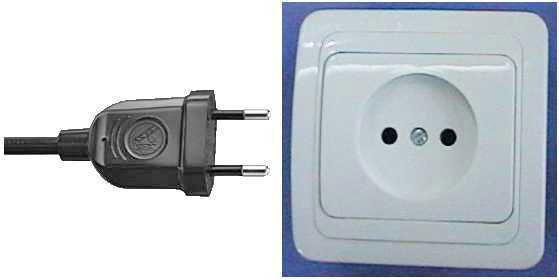- This plug is technically known as the CEE 7/16 (Europlug 2.5 A/250 V unearthed). A plug with an identical appearance with slightly larger pins is technically known as the CEE 7/17 (German/French 16 A/250 V unearthed). This type of plug is very common in most "universal" adaptor sets. Though the photo shows a circular receptacle, quite often Type C plugs have a rectangular or oblong form factor, as shown above.
This two-pin plug is probably the single most widely used international plug, popularly known as the Europlug. The plug is unearthed and has two round pins, which usually converge slightly. It can be inserted into any socket that accepts 4 mm round contacts spaced 19 mm apart. The Europlug is used throughout continental Europe as well as parts of the Middle East, and much of Africa, South America, Central Asia and the former Soviet republics. This plug is intended for use with devices that require 2.5 A or less. Because it can be inserted in either direction into the socket, live and neutral are connected at random.
The separation and length of the pins allow its safe
insertion in most CEE 7/17, Type E, Type F, Type H, and some Type L outlets.
The CEE
7/17 plug also has two round pins but the pins are 4.8 mm in diameter like
Types E and F. The plug has a round plastic or
rubber base that stops it being inserted into small sockets intended for the
Europlug. Instead, it fits only into large round sockets intended for types E and F. The base has holes to accommodate
both side contacts and socket earth pins.
